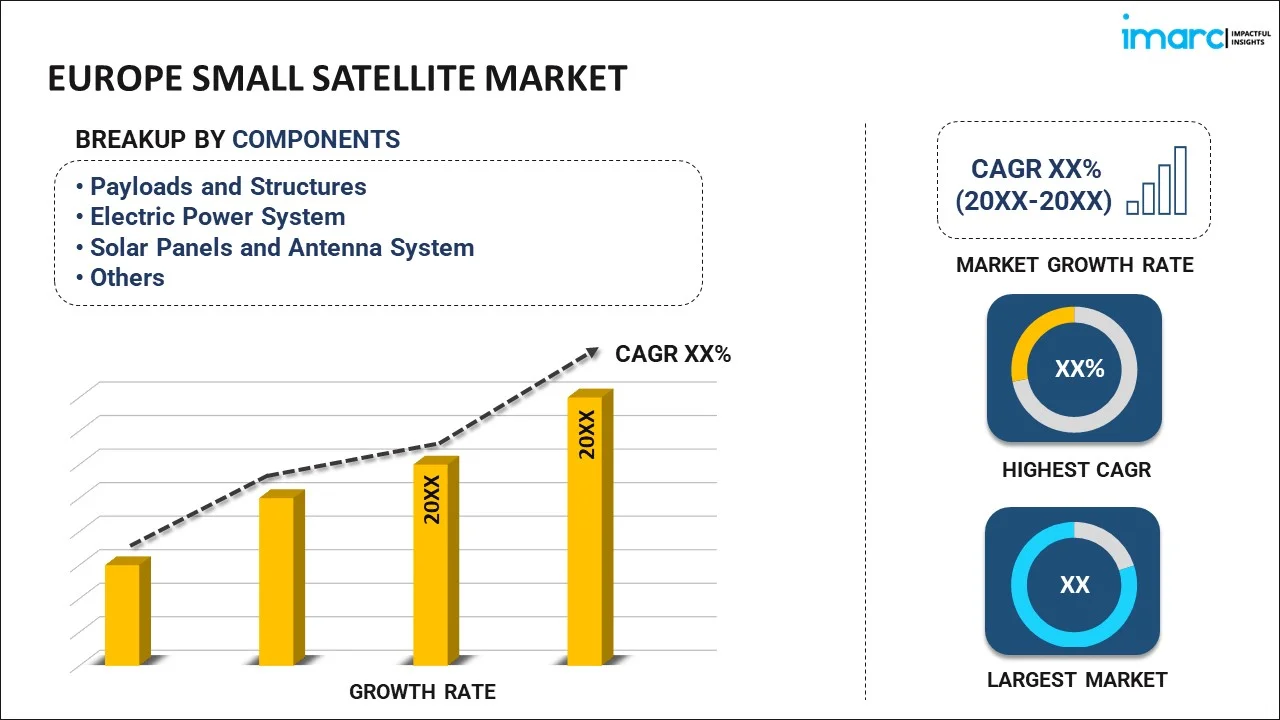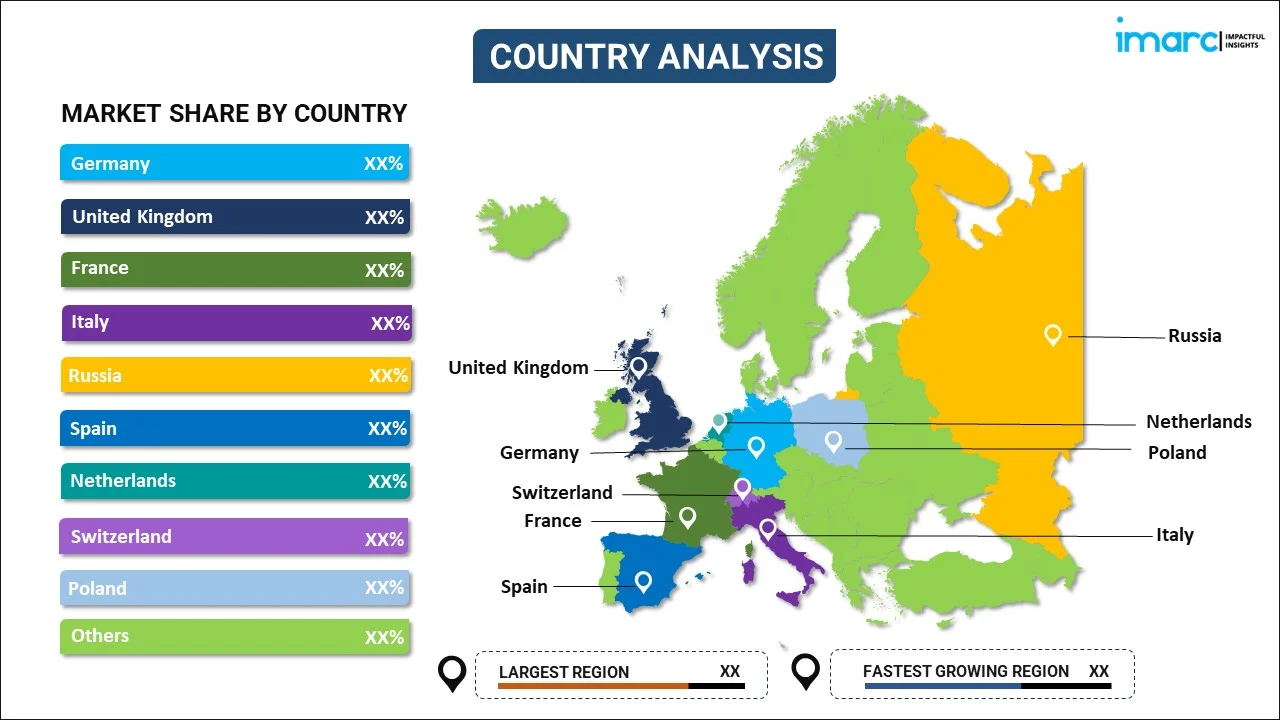
Europe Small Satellite Market Report by Component (Payloads and Structures, Electric Power System, Solar Panels and Antenna System, Propulsion System, and Others), Type (Mini Satellite, Micro Satellite, Nano Satellite, and Others), Frequency (L-Band, S-Band, C-Band, X-Band, Ku-Band, Ka-Band, Q/V-Band, HF/VHF/UHF-Band, and Others), Application (Communication, Earth Observation and Remote Sensing, Science and Exploration, Mapping and Navigation, Space Observation, and Others), End User (Commercial, Academic, Government and Military, and Others), and Country 2025-2033
Market Overview:
Europe small satellite market size reached USD 1,233.4 Million in 2024. Looking forward, IMARC Group expects the market to reach USD 3,068.2 Million by 2033, exhibiting a growth rate (CAGR) of 10.66% during 2025-2033. The ongoing advancements in miniaturization of electronics and other technologies, which enable the creation of smaller, yet powerful, satellite systems, are primarily driving the market growth across the country.
|
Report Attribute
|
Key Statistics
|
|---|---|
|
Base Year
|
2024 |
|
Forecast Years
|
2025-2033
|
|
Historical Years
|
2019-2024
|
| Market Size in 2024 | USD 1,233.4 Million |
| Market Forecast in 2033 | USD 3,068.2 Million |
| Market Growth Rate (2025-2033) | 10.66% |
Small satellites, commonly referred to as smallsats, are compact, lightweight spacecraft designed for various purposes, including Earth observation, communication, scientific research, and technology demonstration. These satellites typically weigh less than 500 kilograms (1,100 pounds) and come in different form factors, such as CubeSats or nanosatellites. Their diminutive size offers cost-effective solutions for space missions, enabling quicker development and deployment compared to larger counterparts. Small satellites often leverage commercial off-the-shelf components and benefit from advancements in miniaturized technology. Despite their size, these satellites contribute significantly to space exploration, providing wide coverage and fostering innovation in the space industry. With growing interest and investment, small satellites play a pivotal role in advancing space capabilities and democratizing access to outer space for a diverse range of applications.
Europe Small Satellite Market Trends:
The small satellite market in Europe has witnessed substantial growth in recent years, driven by several key factors. Firstly, advancements in miniaturized technology have significantly reduced the size and weight of satellite components, enabling the development of smaller, cost-effective satellites. Additionally, the increasing demand for Earth observation data for various applications, such as agriculture, environmental monitoring, and disaster management, has propelled the adoption of small satellites. Moreover, the emergence of new entrants in the space industry, including private companies and startups, has spurred innovation and competition in the small satellite market. These entities are leveraging agile development processes and novel business models to bring about a paradigm shift in satellite manufacturing and deployment. Furthermore, the rise of mega-constellations for regional communication and broadband services has bolstered the demand for small satellites. Companies aiming to establish satellite constellations are opting for smaller satellite units to achieve scalability and cost-effectiveness. This trend is further supported by ongoing advancements in launch vehicle technologies, facilitating the simultaneous deployment of multiple small satellites. In conclusion, the small satellite market in Europe is being driven by a confluence of technological, economic, and market dynamics, making it a pivotal force in the rapidly evolving space industry.
Europe Small Satellite Market Segmentation:
IMARC Group provides an analysis of the key trends in each segment of the market, along with forecasts at the regional and country levels for 2025-2033. Our report has categorized the market based on component, type, frequency, application, and end user.
Component Insights:

- Payloads and Structures
- Electric Power System
- Solar Panels and Antenna System
- Propulsion System
- Others
The report has provided a detailed breakup and analysis of the market based on the component. This includes payloads and structures, electric power system, solar panels and antenna system, propulsion system, and others.
Type Insights:
- Mini Satellite
- Micro Satellite
- Nano Satellite
- Others
A detailed breakup and analysis of the market based on the type have also been provided in the report. This includes mini satellite, micro satellite, nano satellite, and others.
Frequency Insights:
- L-Band
- S-Band
- C-Band
- X-Band
- Ku-Band
- Ka-Band
- Q/V-Band
- HF/VHF/UHF-Band
- Others
The report has provided a detailed breakup and analysis of the market based on the frequency. This includes L-band, S-band, C-band, X-band, Ku-band, Ka-band, Q/V-band, HF/VHF/UHF-band, and others.
Application Insights:
- Communication
- Earth Observation and Remote Sensing
- Science and Exploration
- Mapping and Navigation
- Space Observation
- Others
A detailed breakup and analysis of the market based on the application have also been provided in the report. This includes communication, earth observation and remote sensing, science and exploration, mapping and navigation, space observation, and others.
End User Insights:
- Commercial
- Academic
- Government and Military
- Others
The report has provided a detailed breakup and analysis of the market based on the end user. This includes commercial, academic, government and military, and others.
Country Insights:

- Germany
- United Kingdom
- France
- Italy
- Russia
- Spain
- Netherlands
- Switzerland
- Poland
- Others
The report has also provided a comprehensive analysis of all the major regional markets, which include Germany, United Kingdom, France, Italy, Russia, Spain, Netherlands, Switzerland, Poland, and Others.
Competitive Landscape:
The market research report has also provided a comprehensive analysis of the competitive landscape. Competitive analysis such as market structure, key player positioning, top winning strategies, competitive dashboard, and company evaluation quadrant has been covered in the report. Also, detailed profiles of all major companies have been provided.
Europe Small Satellite Market Report Coverage:
| Report Features | Details |
|---|---|
| Base Year of the Analysis | 2024 |
| Historical Period | 2019-2024 |
| Forecast Period | 2025-2033 |
| Units | Million USD |
| Scope of the Report | Exploration of Historical Trends and Market Outlook, Industry Catalysts and Challenges, Segment-Wise Historical and Future Market Assessment:
|
| Components Covered | Payloads and Structures, Electric Power System, Solar Panels and Antenna System, Propulsion System, Others |
| Types Covered | Mini Satellite, Micro Satellite, Nano Satellite, Others |
| Frequencies Covered | L-Band, S-Band, C-Band, X-Band, Ku-Band, Ka-Band, Q/V-Band, HF/VHF/UHF-Band, Others |
| Applications Covered | Communication, Earth Observation and Remote Sensing, Science and Exploration, Mapping and Navigation, Space Observation, Others |
| End Users Covered | Commercial, Academic, Government and Military, Others |
| Countries Covered | Germany, United Kingdom, France, Italy, Russia, Spain, Netherlands, Switzerland, Poland, Others |
| Customization Scope | 10% Free Customization |
| Post-Sale Analyst Support | 10-12 Weeks |
| Delivery Format | PDF and Excel through Email (We can also provide the editable version of the report in PPT/Word format on special request) |
Key Questions Answered in This Report:
- How has the Europe small satellite market performed so far and how will it perform in the coming years?
- What has been the impact of COVID-19 on the Europe small satellite market?
- What is the breakup of the Europe small satellite market on the basis of component?
- What is the breakup of the Europe small satellite market on the basis of type?
- What is the breakup of the Europe small satellite market on the basis of frequency?
- What is the breakup of the Europe small satellite market on the basis of application?
- What is the breakup of the Europe small satellite market on the basis of end user?
- What are the various stages in the value chain of the Europe small satellite market?
- What are the key driving factors and challenges in the Europe small satellite?
- What is the structure of the Europe small satellite market and who are the key players?
- What is the degree of competition in the Europe small satellite market?
Key Benefits for Stakeholders:
- IMARC’s industry report offers a comprehensive quantitative analysis of various market segments, historical and current market trends, market forecasts, and dynamics of the Europe small satellite market from 2019-2033.
- The research report provides the latest information on the market drivers, challenges, and opportunities in the Europe small satellite market.
- Porter's five forces analysis assist stakeholders in assessing the impact of new entrants, competitive rivalry, supplier power, buyer power, and the threat of substitution. It helps stakeholders to analyze the level of competition within the Europe small satellite industry and its attractiveness.
- Competitive landscape allows stakeholders to understand their competitive environment and provides an insight into the current positions of key players in the market.
Need more help?
- Speak to our experienced analysts for insights on the current market scenarios.
- Include additional segments and countries to customize the report as per your requirement.
- Gain an unparalleled competitive advantage in your domain by understanding how to utilize the report and positively impacting your operations and revenue.
- For further assistance, please connect with our analysts.
 Inquire Before Buying
Inquire Before Buying
 Speak to an Analyst
Speak to an Analyst
 Request Brochure
Request Brochure
 Request Customization
Request Customization




.webp)




.webp)












